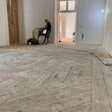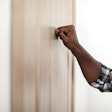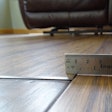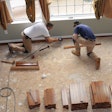Have you had issues like this before? There’s a complaint on your wood floor and the blame game begins: The seller (often the retailer) says it’s an installer problem, and the installer says it’s a manufacturer issue, and the buyer (the homeowner) doesn’t care because the floor is under warranty. It seems we always assume the liability will be passed uphill or downhill—until the inspector gets involved and finds the deficiencies.
What if the material is discontinued? Without boards available for a repair, the problem may require full replacement. Who pays the bill?
Of course, in these situations, nobody wants to cough up the money to replace the floor as a goodwill gesture, so an inspector must be called in to determine the cause. In many cases, this will require destructive testing. Was there material left behind? I find it’s a common problem that the seller doesn’t plan on leaving one full box for “attic stock.” What if the material is discontinued? Without boards available for a repair, the problem may require full replacement. Who pays the bill?
Say the problem is what we call “lippage” on the sides of the planks due to dry cupping and low moisture content. The buyers (the homeowners) remind the seller the floor is under warranty and want it replaced. Whose warranty will it fall under?
Once the inspection is complete of the dry-cupped floor, it is apparent there were no installation or manufacturing problems; rather, low MC of the flooring is the cause. Now the buyers state they never received any maintenance guidelines from the seller (the retailer), so they didn’t know what to keep the RH at.
If that is true and the seller sold the material and contracted the labor with the installer to the buyer, responsibility would fall under the seller’s “expressed” warranty. An expressed warranty is, for example, when the seller says, “No worries, this engineered floor is more stable and doesn’t move like solid wood floors,” … and then the floor cups and has elevated edges. Additionally, failure to supply the manufacturer’s environmental maintenance guidelines is on the seller. (If there were an installation issue, the claim would still be against the seller, since the seller contracted with the installer, and the seller would have to work it out with the installer later.)
Don’t get trapped by saying something you cannot support—you may be on the hook for it.
Unless it was disclaimed, the buyer’s purchase is also covered by the “implied warranty” of merchantability. Basically that means the product is guaranteed to perform, in this case, in a manner suitable for a floor. However, with the floor having lippage, the buyers’ baby is getting splinters while crawling, so the floor is no longer fit for a particular purpose.
The point here is: Be clear on the legal responsibilities every time you do a job, and don’t get trapped by saying something you cannot support—you may be on the hook for it. Always read the manufacturer’s installation, maintenance and warranty guidelines. They are there for a reason: protection. When you sell a floor, protect yourself from the exposure of liability and ensure all guidelines are followed, and disclose product performance capabilities before the sale.


































